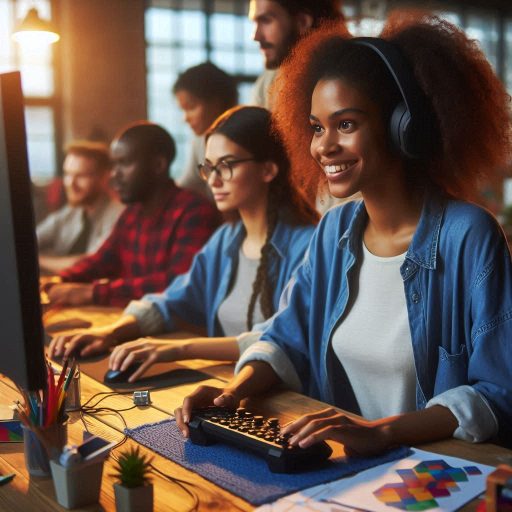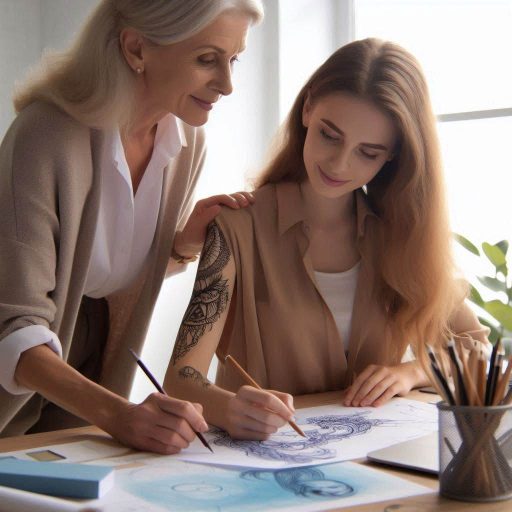Introduction
Collaboration is crucial in game design, fostering creativity and innovation among team members.
In a field that requires diverse expertise, effective collaboration allows teams to combine unique skills and perspectives.
This synergy leads to the development of more polished and engaging games, ultimately improving the player experience.
Developers play a vital role in the game design process.
They bring essential technical knowledge, transforming creative ideas into functional products.
Designers may envision a game filled with intricate mechanics and stunning visuals, but developers make those visions a reality.
By collaborating closely with designers, developers help shape the game’s mechanics, features, and overall structure.
Their input ensures that the design aligns with technical capabilities, allowing for feasibility and functionality.
Regular communication between designers and developers is essential.
It helps identify challenges early in the process, allowing for timely adjustments before issues escalate.
Developers contribute to optimizing performance and ensuring a smooth user experience.
This partnership fosters effective problem-solving and rapid prototyping, allowing teams to iterate quickly on ideas.
Moreover, successful collaboration creates a positive team dynamic, enhancing morale and motivation.
When everyone works toward a shared vision, it can lead to innovative solutions that elevate the game.
Ultimately, collaboration between designers and developers enhances the overall quality of the game.
Understanding the Role of Developers
Specific Responsibilities of Developers in Game Design
Game design is a collaborative process that thrives on teamwork.
Developers play a vital role in bringing game concepts to life.
They are responsible for coding and implementing game mechanics.
Their expertise shapes the overall functionality of the game.
A game‘s success often hinges on how well developers execute their responsibilities.
Developers begin by translating design documents into code.
They take ideas from designers and create the underlying architecture.
This work involves creating algorithms that define how the game operates.
Developers ensure that all elements work together seamlessly.
They address technical challenges and troubleshoot issues as they arise.
One of the primary responsibilities of developers is to build game engines.
These engines serve as the framework for the game.
Developers select the right tools and technologies to create a robust engine.
They also optimize performance to ensure a smooth gaming experience.
By using the latest programming languages, developers enhance the game’s capabilities.
In addition to building engines, developers implement graphics and audio systems.
They work closely with artists and sound designers to integrate visuals and sounds.
This collaboration ensures that the game‘s aesthetic aligns with the design vision.
Developers utilize APIs and other tools to achieve the desired effects.
Their attention to detail enhances the overall user experience.
Technical Knowledge and Skills That Contribute to the Process
Developers must also stay updated on emerging technologies.
Knowledge of VR, AR, and AI is increasingly essential in game design.
They leverage these technologies to create immersive experiences.
This expertise allows them to push the boundaries of traditional game mechanics.
As a result, developers contribute significantly to innovation within the industry.
Collaboration is critical in the game development process.
Developers communicate frequently with designers, artists, and producers.
They participate in brainstorming sessions to provide technical insights.
By sharing their knowledge, they help shape design decisions.
This partnership fosters a cohesive vision that enhances the game‘s quality.
Moreover, developers write and maintain documentation throughout the process.
This documentation is crucial for future reference and updates.
It allows other team members to understand the code and functionality.
Clear documentation also aids in onboarding new developers to the project.
Basically, developers play a pivotal role in game design.
Their responsibilities include coding, building engines, and integrating graphics and audio.
Their technical knowledge and skills contribute significantly to the game’s success.
By collaborating with designers and artists, developers help create engaging experiences.
This teamwork drives the evolution of game design, leading to innovative and captivating games.
As the industry evolves, the importance of developers will only continue to grow.
Their contributions shape the future of gaming, making collaboration essential for success.
Benefits of Collaborating with Developers
How Working with Developers Can Enhance the Overall Quality of the Game
In game design, collaboration with developers is crucial for success.
Working closely with developers enhances the overall quality of the game.
Designers bring creative visions, while developers provide the technical expertise to implement those ideas.
This partnership ensures a seamless integration of art and technology, resulting in a polished final product.
Developers contribute valuable skills that enhance gameplay mechanics and user experience.
They translate design concepts into functional code, allowing players to interact with the game environment.
This collaboration leads to better gameplay flow and intuitive controls.
When designers and developers work together, they identify potential issues early in the process.
This proactive approach reduces the likelihood of costly revisions later on.
Moreover, developers offer insights into technical feasibility.
They can highlight the limitations of current technology and suggest innovative solutions.
By understanding these constraints, designers can create more realistic and achievable concepts.
This collaboration fosters a productive dialogue that leads to a more refined game design process.
Developers can also suggest optimizations that improve performance and enhance visual fidelity.
How Developers Can Help Bring Creative Ideas to Life Through Programming and Coding
Working with developers allows designers to explore new technologies and tools.
For example, incorporating virtual reality (VR) or augmented reality (AR) can elevate a game‘s appeal.
Developers can help assess the feasibility of these technologies and implement them effectively.
This partnership ensures that the final product remains cutting-edge and engaging.
Furthermore, developers can help bring creative ideas to life through programming and coding.
Designers often envision unique gameplay mechanics or intricate storylines.
However, it is the developers who transform these ideas into reality.
They create the underlying systems that make gameplay mechanics functional.
This process includes programming character behaviors, designing artificial intelligence, and implementing complex physics systems.
Developers also assist in refining user interfaces (UI) and user experiences (UX).
They ensure that menus, controls, and interactions are intuitive and enjoyable.
A well-designed UI enhances player immersion and satisfaction, making it easier for players to engage with the game.
This collaboration is vital for creating a polished and enjoyable gaming experience.
Additionally, regular communication between designers and developers fosters a strong team dynamic.
Weekly meetings and brainstorming sessions encourage creativity and problem-solving.
This collaborative environment allows for the sharing of ideas, ensuring everyone is on the same page.
A strong relationship between designers and developers ultimately leads to a more cohesive game.
Read: Breaking Down Iconic Movie Costumes
Effective Communication with Developers
Importance of Clear and Open Communication with Developers
Collaboration between designers and developers is vital in game design.
Effective teamwork fosters creativity and innovation, leading to successful projects.
Clear and open communication serves as the foundation for this collaboration.
Establishing an environment where team members feel comfortable sharing ideas is crucial for success.
Open communication promotes understanding and alignment between designers and developers.
When designers articulate their vision, developers can translate these ideas into practical solutions.
Encourage regular meetings to discuss progress and address any challenges.
These meetings help ensure everyone is on the same page.
They also provide opportunities for brainstorming and refining concepts.
Tips on How to Effectively Convey Design Ideas and Collaborate Seamlessly
Use visual aids to enhance communication.
Diagrams, sketches, and prototypes can effectively convey design ideas.
Visual representations help developers grasp the intended user experience.
They also clarify complex concepts that may be difficult to explain verbally.
Utilize tools like wireframes and mockups to visualize the project.
This approach can save time and prevent misunderstandings later in the development process.
When discussing design ideas, focus on the end-user experience.
Explain how specific features contribute to player engagement and enjoyment.
This context helps developers understand the rationale behind design choices.
It also fosters a shared sense of purpose within the team.
Collaboratively identify potential challenges and brainstorm solutions early in the process.
Addressing issues upfront can prevent costly changes during later stages of development.
Encourage feedback throughout the collaboration process.
Developers bring valuable insights and perspectives that can enhance design.
Create a culture where constructive criticism is welcomed.
Actively seek input on design concepts, as this fosters mutual respect.
Open dialogue about strengths and weaknesses leads to better outcomes.
Be flexible and adaptable in your collaboration.
Game design often requires adjustments based on technical feasibility.
Developers may suggest alternative solutions that align with design goals.
Embrace these suggestions, as they can lead to innovative outcomes.
Flexibility in communication ensures that both parties feel heard and valued.
Leverage project management tools to streamline collaboration.
Tools like Trello, Asana, or Slack help organize tasks and facilitate communication.
These platforms provide a centralized space for discussions, updates, and file sharing.
Keeping everyone informed fosters accountability and transparency within the team.
Read: Freelance vs. In-House Costume Design Jobs
Building a Strong Relationship with Developers
Collaborating with developers in game design is a crucial aspect of creating successful and engaging games.
To ensure a smooth and effective partnership, it is essential to build a strong relationship with developers.
Here are some tips on how to do so
Fostering a positive and productive relationship with developers
- Communicate openly and transparently: Clear and constant communication is key to building trust and understanding between game designers and developers.
- Show respect for their expertise: Acknowledge the unique skills and knowledge that developers bring to the table and trust their judgment.
- Be open to feedback: Embrace constructive criticism and be willing to make adjustments based on the developers’ suggestions.
- Establish common goals: Ensure that both game designers and developers are aligned on the overall vision and objectives of the project.
- Celebrate successes together: Recognize and appreciate the hard work and achievements of developers to foster a positive working relationship.
Ways to create a collaborative and cohesive team dynamic
- Promote teamwork and collaboration: Encourage open discussions and brainstorming sessions to foster creativity and innovation.
- Define clear roles and responsibilities: Ensure that each team member, including game designers and developers, understands their specific tasks and contributions.
- Respect each other’s expertise: Recognize and value the unique skills and perspectives that developers bring to the game design process.
- Encourage diversity and inclusion: Create an inclusive environment where all team members feel valued and heard, regardless of their background or experience.
- Provide opportunities for professional growth: Support developers in expanding their skills and knowledge through training and mentorship programs.
By following these tips, game designers can establish a strong and collaborative relationship with developers, leading to successful and high-quality game projects.
Read: Networking Events for Costume Designers

Incorporating Feedback from Developers
How to Handle Feedback from Developers and Incorporate Their Suggestions into the Design
When you receive feedback from developers, approach it with an open mind.
Their insights often stem from their technical expertise and experience in game mechanics.
Instead of feeling defensive, view feedback as an opportunity for improvement.
Take notes on their suggestions, and ask clarifying questions when needed.
This engagement shows your willingness to learn and collaborate effectively.
After gathering feedback, evaluate the suggestions in the context of your design goals.
Not every suggestion will align with your vision, and that‘s okay.
Prioritize feedback that enhances gameplay, user experience, or performance.
Be transparent about your decisions, and explain why certain suggestions may not be feasible.
This transparency fosters trust and encourages developers to continue sharing their insights.
As you incorporate feedback, consider creating prototypes to visualize changes.
This approach allows you to test new ideas quickly and efficiently.
Share these prototypes with developers to gather further input.
They can offer additional perspectives on functionality and performance, ensuring a smoother implementation process.
Benefits of Iterative Design Processes in Collaboration with Developers
Iterative design processes provide numerous benefits when collaborating with developers.
This method emphasizes continuous improvement through repeated cycles of design, feedback, and refinement.
As you develop a game, each iteration builds on the last, enhancing the final product.
One significant advantage of iterative design is the ability to identify and resolve issues early.
Developers can spot potential technical challenges before they escalate into major problems.
By addressing these issues promptly, you save time and resources in the long run.
This proactive approach leads to a more polished and functional game.
Additionally, iterative design promotes creativity and innovation.
As developers contribute their expertise, they often inspire new ideas and solutions.
This collaborative environment encourages experimentation, allowing you to explore various design possibilities.
By valuing each team member’s input, you foster a culture of creativity that benefits the entire project.
Moreover, iterative design facilitates regular communication and feedback loops.
Frequent check-ins with developers ensure everyone stays aligned on project goals.
This ongoing dialogue helps you address concerns promptly and make necessary adjustments.
Read: Building a Portfolio for Costume Design
See Related Content: Creative Director in Film and TV: A Unique Role
Addressing Challenges in Collaboration
Common Challenges That May Arise When Working With Developers
Collaborating with developers in game design presents unique opportunities and challenges.
Understanding these challenges can help foster a successful partnership.
Communication issues often arise when designers and developers have different priorities.
Designers focus on creative aspects, while developers emphasize technical constraints.
Misunderstandings can lead to frustration and delays.
Additionally, managing expectations can be difficult.
Designers may envision elaborate features that are challenging to implement.
Developers may struggle to meet tight deadlines while ensuring quality.
Both parties need to agree on realistic timelines and deliverables.
Scope creep is another significant issue in game development.
Designers often want to add new features throughout the project.
This tendency can overwhelm developers and push deadlines further away.
Balancing creativity and technical feasibility is crucial, as designers might propose ideas not feasible within the existing framework.
Developers must provide feedback on what is achievable within the project’s constraints.
Strategies for Overcoming Obstacles and Maintaining a Successful Partnership
To address communication issues, establish clear communication channels from the outset.
Regular check-ins can help ensure everyone stays aligned on project goals.
Use project management tools to set milestones and track progress.
This approach can keep everyone accountable and focused.
To prevent scope creep, create a well-defined project plan.
Outline the project‘s core features and stick to them.
If new ideas emerge, evaluate their impact on the timeline before implementation.
This practice maintains focus and ensures project success.
Fostering a collaborative culture is essential for successful partnerships.
Recognize and celebrate the contributions of both designers and developers.
This acknowledgment creates a positive work environment and motivates team members.
Organize team-building activities to strengthen relationships and improve collaboration.
Shared experiences can enhance trust and understanding among team members.
Establish a feedback process that values input from both sides.
Encourage constructive criticism and a willingness to iterate.
This approach creates a culture of continuous improvement, benefiting the final product.
Lastly, recognize the importance of documentation.
Poor documentation can lead to confusion and miscommunication.
Maintain thorough records of decisions, changes, and project requirements.
This practice ensures everyone has access to the same information, reducing misunderstandings.
Leveraging Each Other’s Strengths
Encourage designers to recognize and leverage the unique strengths of developers
When game designers and developers collaborate, it is crucial for designers to understand and appreciate the unique strengths that developers bring to the table.
Developers possess technical expertise, problem-solving skills, and a deep understanding of the capabilities and limitations of game engines.
By recognizing and leveraging these strengths, designers can create more impactful and polished game experiences.
Designers should actively seek input and feedback from developers throughout the game design process.
Developers can offer valuable insights on how to optimize gameplay mechanics, improve user experience, and address technical challenges.
By working hand in hand with developers, designers can refine their ideas and ensure that they are feasible and implementable within the confines of the game development environment.
Collaboration can lead to innovative solutions and enhance the final product
Furthermore, collaboration between designers and developers often leads to the emergence of innovative solutions that would not have been possible otherwise.
Developers can propose creative ways to implement design ideas, optimize performance, and overcome technical hurdles.
Designers, on the other hand, can offer fresh perspectives, unique gameplay concepts, and artistic direction that inspire developers to push the boundaries of what is achievable within a game project.
By combining their skills and expertise, designers and developers can create synergistic relationships that result in a final product that is greater than the sum of its parts.
This synergy enables teams to integrate design elements and technical features seamlessly.
As a result, they create a cohesive and immersive game experience.
Such an experience captivates players and helps the game stand out in a crowded market.
Ultimately, collaboration between designers and developers is essential for the success of any game project.
By leveraging each other’s strengths, designers and developers work together toward a common goal.
This collaboration unlocks their full creativity and technical expertise.
As a result, they create groundbreaking games that resonate with players.
These games leave a lasting impact on the industry.
Transform Your Career Today
Unlock a personalized career strategy that drives real results. Get tailored advice and a roadmap designed just for you.
Start NowConclusion
Collaboration with developers is vital for successful game design, impacting every aspect of the creative process.
Throughout this blog, we explored how teamwork enhances both creativity and efficiency in game development.
Game design is a multifaceted endeavor, involving various disciplines, including art, programming, sound design, and storytelling.
By working together, designers and developers can create a cohesive vision that elevates the final product and ensures a seamless player experience.
Effective communication between designers and developers fosters a shared understanding of project goals and objectives.
This collaboration leads to innovative solutions and helps address challenges promptly as they arise.
We discussed how iterative feedback loops play a crucial role in refining gameplay mechanics, art styles, and user interfaces.
Involving developers early in the design process can prevent costly revisions later and save time in the long run.
Moreover, strong relationships among team members create a positive and collaborative work environment.
When everyone feels valued and heard, creativity flourishes, resulting in better ideas and outcomes.
As team members share their unique perspectives, they can discover new opportunities for gameplay innovations and improvements.




